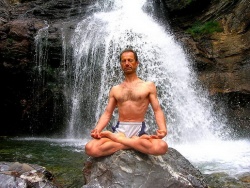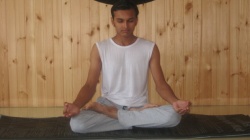Difference between revisions of "Lotus seat"
(Created page with "thumb|250px| thumb|250px| <poem> The Lotus Position (Sanskrit: पद्मासन pɐd̪mɑːs̪ɐn̪ɐ...") |
|||
| Line 1: | Line 1: | ||
[[File:Padmasana45.JPG|thumb|250px|]] [[File:41patel_Yoga.jpg|thumb|250px|]] | [[File:Padmasana45.JPG|thumb|250px|]] [[File:41patel_Yoga.jpg|thumb|250px|]] | ||
<poem> | <poem> | ||
| − | The [[Lotus Position]] ([[Sanskrit]]: [[पद्मासन]] [[pɐd̪mɑːs̪ɐn̪ɐ]], IAST: [[padmāsana]]) is a cross-legged sitting [[asana]] originating in [[meditative]] practices of {{Wiki|ancient India}}, in which the feet are placed on the opposing thighs. It is an established [[asana]], commonly used for [[meditation]], in the [[Hindu]] [[Yoga]], [[Jain]] and [[Buddhist]] contemplative [[traditions]]. The [[asana]] is said to resemble a [[lotus]], to encourage [[breathing]] proper to associated [[meditative]] practice, and to foster [[physical]] stability. | + | The [[Lotus Position]] ([[Sanskrit]]: [[पद्मासन]] [[pɐd̪mɑːs̪ɐn̪ɐ]], IAST: [[padmāsana]]) is a cross-legged sitting [[asana]] originating in [[meditative]] practices of {{Wiki|ancient India}}, in which the feet are placed on the opposing thighs. It is an established [[asana]], commonly used for [[meditation]], in the [[Hindu]] [[Yoga]], [[Jain]] and [[Buddhist]] {{Wiki|contemplative}} [[traditions]]. The [[asana]] is said to resemble a [[lotus]], to encourage [[breathing]] proper to associated [[meditative]] practice, and to foster [[physical]] stability. |
[[Shiva]], the [[meditating]] [[ascetic]] [[God]] of [[Hinduism]], [[Siddhartha Gautama]], the founder of [[Buddhism]], and the [[Jinas]] of [[Jainism]] have been depicted in the [[lotus position]]. | [[Shiva]], the [[meditating]] [[ascetic]] [[God]] of [[Hinduism]], [[Siddhartha Gautama]], the founder of [[Buddhism]], and the [[Jinas]] of [[Jainism]] have been depicted in the [[lotus position]]. | ||
| − | [[Padmāsana]] means "[[Lotus throne]]" and is also a term for actual thrones, often decorated with [[lotus]] foliage motifs, on which figures in [[art]] sit. In Balinese [[Hinduism]], a prominent feature of [[temples]] is a special [[form]] of [[padmasana]] [[shrine]], with [[empty]] thrones mounted on a column, for [[deities]], especially [[Acintya]]. | + | [[Padmāsana]] means "[[Lotus throne]]" and is also a term for actual thrones, often decorated with [[lotus]] foliage motifs, on which figures in [[art]] sit. In {{Wiki|Balinese}} [[Hinduism]], a prominent feature of [[temples]] is a special [[form]] of [[padmasana]] [[shrine]], with [[empty]] thrones mounted on a column, for [[deities]], especially [[Acintya]]. |
In [[Chinese Buddhism]], the [[lotus position]] is also called the "[[vajra position]]" (Skt. [[vajrāsana]], Ch. [[金剛座]] [[jīngāngzuò]]). The [[traditions]] of [[Tibetan Buddhism]] also refer to the [[lotus position]] as the "[[vajra position]]. | In [[Chinese Buddhism]], the [[lotus position]] is also called the "[[vajra position]]" (Skt. [[vajrāsana]], Ch. [[金剛座]] [[jīngāngzuò]]). The [[traditions]] of [[Tibetan Buddhism]] also refer to the [[lotus position]] as the "[[vajra position]]. | ||
| Line 13: | Line 13: | ||
From the common sitting down on the floor ([[Indian]] Style, Cross-legged) position ([[asana]]), one foot is placed on top of the opposite thigh with its sole facing upward and heel close to the {{Wiki|abdomen}}. The other foot is then lifted up slowly and placed on the opposite thigh in a symmetrical way. | From the common sitting down on the floor ([[Indian]] Style, Cross-legged) position ([[asana]]), one foot is placed on top of the opposite thigh with its sole facing upward and heel close to the {{Wiki|abdomen}}. The other foot is then lifted up slowly and placed on the opposite thigh in a symmetrical way. | ||
| − | The knees are in [[contact]] with the ground. The torso is placed in [[balance]] and alignment such that the spinal column supports it with minimal muscular [[effort]]. The torso is centered above the hips. To [[relax]] the head and neck, the jaw is allowed to fall towards the neck and the back of the neck to lengthen. The shoulders move backwards and the ribcage lifts. The {{Wiki|tongue}} rests on the roof of the {{Wiki|mouth}}. The hands may rest on the knees in chin or [[jnana mudra]]. The arms are [[relaxed]] with the elbows slightly bent. | + | The knees are in [[contact]] with the ground. The torso is placed in [[balance]] and alignment such that the [[spinal column]] supports it with minimal muscular [[effort]]. The torso is centered above the hips. To [[relax]] the head and neck, the jaw is allowed to fall towards the neck and the back of the neck to lengthen. The shoulders move backwards and the ribcage lifts. The {{Wiki|tongue}} rests on the roof of the {{Wiki|mouth}}. The hands may rest on the knees in [[chin]] or [[jnana mudra]]. The arms are [[relaxed]] with the elbows slightly bent. |
The [[eyes]] may be closed, the [[body]] [[relaxed]], with [[awareness]] of the overall [[asana]]. Adjustments are made until [[balance]] and alignment are [[experienced]]. Alignment that creates [[relaxation]] is indicative of a suitable position for the [[asana]]. The [[asana]] should be natural and comfortable, without any sharp [[pains]]. | The [[eyes]] may be closed, the [[body]] [[relaxed]], with [[awareness]] of the overall [[asana]]. Adjustments are made until [[balance]] and alignment are [[experienced]]. Alignment that creates [[relaxation]] is indicative of a suitable position for the [[asana]]. The [[asana]] should be natural and comfortable, without any sharp [[pains]]. | ||
| Line 20: | Line 20: | ||
Contra-indications | Contra-indications | ||
| − | Those without sufficient [[flexibility]] to place both knees on the ground when in full [[lotus position]] should not use it, as it strains the knees and lower back of such [[people]]. Other [[meditation]] [[asanas]] are indicated until sufficient [[flexibility]] has been developed to sit comfortably in the [[Lotus]]. Sciatica, sacral infections and weak or injured knees are contra-indications to attempting the [[asana]]. | + | Those without sufficient [[flexibility]] to place both knees on the ground when in full [[lotus position]] should not use it, as it strains the knees and lower back of such [[people]]. Other [[meditation]] [[asanas]] are indicated until sufficient [[flexibility]] has been developed to sit comfortably in the [[Lotus]]. Sciatica, [[sacral]] infections and weak or injured knees are contra-indications to attempting the [[asana]]. |
Benefits | Benefits | ||
| − | The [[Lotus position]] is adopted to allow the [[body]] to be held completely steady for long periods of [[time]]. This allows the [[mind]] to calm—the first step towards [[meditation]]. The [[asana]] applies pressure to the lower spine which may facilitate [[relaxation]]. The [[breath]] can slow down, muscular tension {{Wiki|decrease}} and {{Wiki|blood}} pressure subside. The coccygeal and sacral nerves are toned as the normally large {{Wiki|blood}} flow to the {{Wiki|legs}} is redirected to the abdominal region, which may help to improve digestion. | + | The [[Lotus position]] is adopted to allow the [[body]] to be held completely steady for long periods of [[time]]. This allows the [[mind]] to calm—the first step towards [[meditation]]. The [[asana]] applies pressure to the lower spine which may facilitate [[relaxation]]. The [[breath]] can slow down, muscular tension {{Wiki|decrease}} and {{Wiki|blood}} pressure subside. The coccygeal and [[sacral]] {{Wiki|nerves}} are toned as the normally large {{Wiki|blood}} flow to the {{Wiki|legs}} is redirected to the abdominal region, which may help to improve {{Wiki|digestion}}. |
</poem> | </poem> | ||
{{W}} | {{W}} | ||
[[Category:Asanas]] | [[Category:Asanas]] | ||
Revision as of 07:47, 7 February 2023
The Lotus Position (Sanskrit: पद्मासन pɐd̪mɑːs̪ɐn̪ɐ, IAST: padmāsana) is a cross-legged sitting asana originating in meditative practices of ancient India, in which the feet are placed on the opposing thighs. It is an established asana, commonly used for meditation, in the Hindu Yoga, Jain and Buddhist contemplative traditions. The asana is said to resemble a lotus, to encourage breathing proper to associated meditative practice, and to foster physical stability.
Shiva, the meditating ascetic God of Hinduism, Siddhartha Gautama, the founder of Buddhism, and the Jinas of Jainism have been depicted in the lotus position.
Padmāsana means "Lotus throne" and is also a term for actual thrones, often decorated with lotus foliage motifs, on which figures in art sit. In Balinese Hinduism, a prominent feature of temples is a special form of padmasana shrine, with empty thrones mounted on a column, for deities, especially Acintya.
In Chinese Buddhism, the lotus position is also called the "vajra position" (Skt. vajrāsana, Ch. 金剛座 jīngāngzuò). The traditions of Tibetan Buddhism also refer to the lotus position as the "vajra position.
Position
From the common sitting down on the floor (Indian Style, Cross-legged) position (asana), one foot is placed on top of the opposite thigh with its sole facing upward and heel close to the abdomen. The other foot is then lifted up slowly and placed on the opposite thigh in a symmetrical way.
The knees are in contact with the ground. The torso is placed in balance and alignment such that the spinal column supports it with minimal muscular effort. The torso is centered above the hips. To relax the head and neck, the jaw is allowed to fall towards the neck and the back of the neck to lengthen. The shoulders move backwards and the ribcage lifts. The tongue rests on the roof of the mouth. The hands may rest on the knees in chin or jnana mudra. The arms are relaxed with the elbows slightly bent.
The eyes may be closed, the body relaxed, with awareness of the overall asana. Adjustments are made until balance and alignment are experienced. Alignment that creates relaxation is indicative of a suitable position for the asana. The asana should be natural and comfortable, without any sharp pains.
In most cases, a cushion (zafu) or mat (zabuton) is necessary in order to achieve this balance. One sits on the forward edge of the cushion or mat in order to incline one's pelvis forward, making it possible to center the spine and provide the necessary support. Only the most flexible people can achieve this asana without a support under their pelvis (and likewise does The Dalai Lama explicitly advise).
Contra-indications
Those without sufficient flexibility to place both knees on the ground when in full lotus position should not use it, as it strains the knees and lower back of such people. Other meditation asanas are indicated until sufficient flexibility has been developed to sit comfortably in the Lotus. Sciatica, sacral infections and weak or injured knees are contra-indications to attempting the asana.
Benefits
The Lotus position is adopted to allow the body to be held completely steady for long periods of time. This allows the mind to calm—the first step towards meditation. The asana applies pressure to the lower spine which may facilitate relaxation. The breath can slow down, muscular tension decrease and blood pressure subside. The coccygeal and sacral nerves are toned as the normally large blood flow to the legs is redirected to the abdominal region, which may help to improve digestion.

